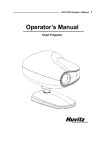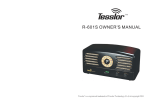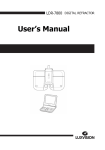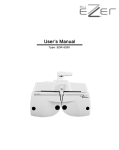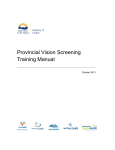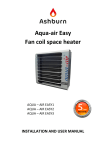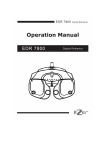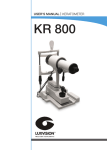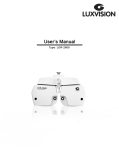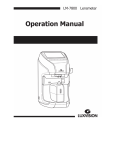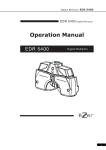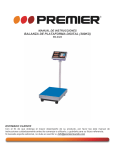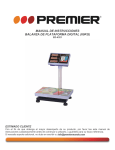Download User`s Manual
Transcript
1 IMPORTANT NOTICE This product may malfunction due to electromagnetic waves caused by portable personal telephones, transceivers, radio-controlled toys, etc. Be sure to avoid having objects such as, which affect this product, brought near the product. 2 CONTENTS 1. Introduction 1.1. Outline of product ....................................................................................................4 1.2. Classifications ...........................................................................................................4 1.3. Standards .................................................................................................................4 1.4. EMC Information ......................................................................................................5 2. Safety Information..........................................................................................................8 2.1 Introduction .............................................................................................................8 2.2 Safety Symbols .........................................................................................................9 2.3 Environmental factors .............................................................................................12 2.4 Safety Precautions ..................................................................................................14 3. Features 4. Notes for Using the Instrument ....................................................................................17 5. Configurations ...........................................................................................................18 5.1 Main Body ..............................................................................................................18 5.2 Main Body cont. .....................................................................................................19 5.3 Accessories .............................................................................................................20 6. Installation 6.1 Position of Chart Projector ......................................................................................21 6.2 How to obtain correct Letter Size and focus ............................................................22 (Zooming Type only) ....................................................................................................22 7. Input and Use of Program ............................................................................................22 3 7.1 How to input user's program .................................................................................. 22 7.2 How to use your stored programs........................................................................... 24 8. Types of Chart .......................................................................................................... 25 9. Maintenance and Repair .......................................................................................... 26 a. Fuse Replacement .................................................................................................. 26 b. Remote Control batteries Replacement................................................................... 27 c. Cleansing .............................................................................................................. 27 d. Disposal Information .............................................................................................. 28 10. Specifications........................................................................................................... 29 11. Components List ...................................................................................................... 30 11.1 Standard accessories ........................................................................................... 30 12. Service Information.................................................................................................. 31 4 1. Introduction 1.1. Outline of product LUXVISION LCP-7800 is an automatic chart projector which provides 41 different charts including red/green, polarized filters, binocular balance test chart, stereoacuity test chart, fixation disparity test chart, fusion test chart and aniseikonia test chart for the eye optometry. Users can select the desired charts instantaneously by cordless remote controller. Charts move quickly and quietly. The customized two programs will help you to perform more convenient and effective examination. This automatic chart project is compatible with LUXVISION digital refractor, CDR series. 1.2. Classifications - Type of protection against electric shock: Class I Equipment - Degree of protection against electric shock: No applied parts - Degree of protection against the ingress of water: Ordinary, IPX0 - Equipment not suitable for use in the presence of a flammable anesthetic mixture with air or with oxygen or nitrous oxide. 1.3. Standards LVD: IEC/EN60601-1 EMC: IEC/EN60601-1-2 5 1.4. EMC Information Table 1:Guidance and manufacturer’s declaration – electromagnetic emissions The LCP-7800 is intended for use in the electromagnetic environment specified below. The customer or the user of the LCP-7800 should assure that it is used in such an environment. Emissions test Compliance Electromagnetic environment - guidance RF emissions CISPR 11 Group 1 The LCP-7800 uses RF energy only for its internal function. Therefore, its RF emissions are very low and are not likely to cause any interference in n earby electronic equipment RF emissions CISPR 11 Class A Harmonic emissions IEC 61000-3-2 Class A Voltage fluctuations/ Flicker emissions IEC 61000-3-3 Complies The LCP-7800 is suitable for use in all establish ments other than domestic and those directly co nnected to the public low-voltage power supply network that supplies buildings used for domesti c purposes Table 2:Guidance and manufacturer’s declaration – electromagnetic immunity The LCP-7800 is intended for use in the electromagnetic environment specified below. The customer or the user of the LCP-7800 should assure that it is used in such an environment. Immunity test IEC 60601 Compliance Electromagnetic environment Test level level guidance Electrostatic ±6 kV contact ±6 kV Floors should be wood, concrete or Discharge(ESD) ±8 kV air contact ceramic tile. If floors are covered with IEC 61000-4-2 ±8 kV air synthetic material, the relative humidity should be at least 30%. Electrical fast ±2 kV for power ±2 kV for Mains power quality should be that of transient/burst supply lines power a typical commercial or hospital IEC 61000-4-4 supply lines environment Surge IEC 61000-4-5 ±1 kV lines to lines ±2 kV lines to earth ±1 to ±2 to kV lines lines kV lines earth Mains power quality should be that of a typical commercial or hospital environment. 6 Voltage dips, short interruptions and voltage variations on power supply input lines IEC 61000-4-11 <5% UT (>95% dip in UT) For 0,5 cycle 40% UT (60% dip in UT) For 5 cycle 70% UT (30% dip in UT) For 25 cycle <5% UT (>95% dip in UT) For 5 cycle <5% UT (>95% dip in UT) For 0,5 cycle 40% UT (60% dip in UT) For 5 cycle 70% UT (30% dip in UT) For 25 cycle <5% UT (>95% dip in UT) For 5 cycle 3A/m Mains power quality should be that of a typical commercial or hospital environment. If the user of LCP-7800 requires continued operation during power mains interruptions, it is recommended that the LCP-7800 be powered from an uninterruptible power supply or a battery. Power frequency (5 3A/m Power frequency magnetic fields sho 0/60Hz) magnetic fi uld be at levels characteristic of a ty eld pical location in a typical commercial IEC 61000-4-8 or hospital environment Note: UT is the a.c. mains voltage prior to application of the test level. Table 3: Guidance and manufacturer’s declaration – electromagnetic immunity The LCP-7800 is intended for use in the electromagnetic environment specified below. The customer or the user of the LCP-7800 should assure that it is used in such an environment. Immunity test IEC 60601 test level Compliance Electromagnetic environment-guidance level Portable and mobile RF communications equipment should be used no closer to any part of the SYSTEM, including cables, than the recommended separation distance calculated from the equation Conducted RF 3 Vrms 3V applicable to the frequency of the IEC 61000-4-6 150 kHz to 80MHz transmitter. Recommended separation distance Radiated RF IEC 61000-4-3 3 Vrms 80MHz to 2.5GHz 3V/m 3 .5 ] P V1 3 .5 d =[ ] P E1 d =[ 80MHz to 800MHz 7 d =[ 7 ] P E1 800MHz to 2.5GHz Where P is the maximum output power rating of the transmitter in watts(W) according to the transmitter manufacturer and d is the recommended separation distance in metres (m). Field strengths from fixed RF transmitters, as determined by an electromagnetic site survey, should be less than the compliance level in each frequency range. Interference may occur in the vicinity of equipment marked wigh the following symbol: Recommended separation distances between portable and mobile RF communications equipment and the LCP-7800 The LCP-7800 is intended for use in an electromagnetic environment in which radiated RF disturbances are controlled. The customer or the user of the LCP-7800 can help prevent electromagnetic interference by maintaining a minimum distance between portable and mobile RF communications equipment ( transmitters ) and the LCP-7800 as recommended below, according to the maximum output power of the communications equipment. Rated maximum Separation distance according to frequency of transmitter output power of transmitter W m 150kHz to 80 MHz d =[ 3 .5 ] P V1 80MHz to 800MHz d =[ 3 .5 ] P E1 800MHz to 2.5GHz d =[ 7 ] P E1 0.01 0.12 0.12 0.23 0.1 0.38 0.38 0.73 1 1.2 1.2 2.3 10 3.8 3.8 7.3 100 12 12 23 8 2. Safety Information 2.1 Introduction Safety is everyone’s responsibility. The safe use of this equipment is largely dependent upon the installer, user, operator, and maintainer. It is imperative that personnel study and become familiar with this entire manual before attempting to install, use, clean, service or adjust this equipment and any associated accessories. It is paramount that the instructions contained in this manual are fully understood and followed to enhance safety to the patient and the user/operator. It is for this reason that the following safety notices have been placed appropriately within the text of this manual to highlight safety related information or information requiring special emphasis. All users, operators, and maintainers must be familiar with and pay particular attention to all Warnings and Cautions incorporated herein. ! WARNING "Warning” indicates the presence of a hazard that could result in severe personal injury, death or substantial property damage if ignored. ! CAUTION “Caution” indicates the presence of a hazard that could result in minor injury, or property damaged if ignored. NOTE This is used to emphasize essential information. Be sure to read this information to avoid operating the device incorrectly. 9 2.2 Safety Symbols The International Electrotechnical Commission (IEC) has established a set of symbols for medical electronic equipment, which classify a connection or warn of any potential hazards. The classifications and symbols are shown below. ON When the switch points to this symbol, power is being supplied to the device. OFF When the switch points to this symbol, power is not being supplied to the device. Input Indicates the Input port. Output Indicates the output port. Caution, Consult accompanying documents. Consult instructions for use Protective Earth Connection Alternating Current 10 European Conformity Dispose of Electrical and Electronic Equipment Correctly Date of manufacture Manufacturer Authorized Representative in the European Community Serial Number Temperature Limitation Humidity Limitation Atmospheric Pressure Limitation 11 This side up Fragile , handle with care Do not use hand hooks Keep Dry Stacking Limit by Number 12 2.3 Environmental factors Avoid the following environments for operation or storage: Where the equipment is exposed to water vapor. Don’t operate an equipment with a wet hand. Where the equipment is exposed to direct sunlight. Where the temperature changes extremely. Normal operating temperature range is from 10℃ to 35℃, Humidity is from 30% to 90%. Where it is near the heat equipment. Where the humidity is extremely high or there is a ventilation problem. Where the equipment is subject to excessive shocks or vibrations. Where equipment is exposed to chemical material or explosive gas. Be careful not to be inserted dust, especially, metal 13 This instrument can withstand the following conditions: 1. Operation - An ambient temperature range of 50°F ~ 95°F (10℃ ~ 35℃) - A relative humidity range of 30% ~ 90% - An atmospheric pressure range of 800 ~ 1060hpa 2. Transportation - An ambient temperature range of -40F ~ 158°F (-40℃ ~ 70℃) - A relative humidity range of 10% ~ 95% - An atmosphere pressure range of 500 ~ 1060hpa 3. Storage - An ambient temperature range of 14°F ~ 131°F (-10℃ ~ 55℃) - A relative humidity range of 10% ~ 95% - An atmosphere pressure range of 700 ~ 1060hpa Avoid environments where the equipment is exposed to excessive shocks or vibrations. 14 2.4 Safety Precautions This equipment has been developed and tested according to national as well as international safety standards. This guarantees a very high degree of safety for this device. The correct handling of this equipment is imperative for its safe operation. Therefore, please read carefully all instructions before switching on this device. For more detailed information, please contact our Customer Service Department or one of our authorized representatives. 1. This equipment must not be used (a) in an area that is in danger of explosions and (b) in the presence of flammable, explosive, or volatile solvents such as alcohol, benzene or similar chemicals. 2. Do not put or use this device in humid rooms. Humidity should be maintained between 30 and 90% for normal operation. Do not expose the device to water splashes, dripping water, or sprayed water. Do not place containers containing fluids, liquids, or gases on top of any electrical equipment or devices. 3. The equipment must be operated only by, or under direct supervision of a properly trained and qualified person. 4. Modifications of this equipment may only be carried out by LUXVISION service technicians or other authorized persons. 5. The manufacturer is only responsible for effects on safety, reliability, and performance of this equipment when the following requirements are fulfilled: (1) The electrical installation in the respective room corresponds to the specifications stated in this manual and (2) This equipment is used, operated, and maintained according to this manual. 6. The manufacturer is not liable for damage caused by unauthorized tampering with the device(s). Such tampering will forfeit any rights to claim under warranty. 7. Only persons who have undergone proper training and instructions are authorized to install, use, operate, and maintain this equipment. 15 8. Keep the User’s Manual in a place easily accessible at all times for persons operating and maintaining the equipment. 9. Please do not pull on any cable. Always hold on to the plug when disconnecting cables. 10. Before every operation, visually check the equipment for exterior mechanical damage(s) and for proper function. 11. Do not cover any ventilation grids or slits. ! WARNING No modification of this equipment is allowed 16 3. Features Bright (LED), high quality images Quiet, instantaneous chart selection 41 different charts including: red/green and polarizing filters, binocular balance tests, stereo tests, fixation disparity tests, fusion tests and Aniseikonia tests. 34 Masks (vertical line, horizontal line, and single character) 2.5 ~ 8 m (8 ~ 26 feet) projection range Cordless Remote Control User Programmable (2 programs up to 30 charts each) Easily networked with LUXVISION Digital Refractor 17 4. Notes for Using the Instrument Do not hit or drop the instrument. The instrument may be damaged if it receives a strong impact. The impact can damage the function of this instrument. Handle it with care. Exposure to direct sunlight or very bright indoor lights can influence the results of measurements. If you want to connect this with other equipment, consult the dealer. Sudden heating of the room in cold areas will cause condensation of vapor on the protective glass in the measurement window and on optical parts inside the instrument. In this case, wait until the condensation disappears before performing measurements. Keep the objective glass of the examinee side clean. If it is stained with other substances or a fingerprint, it may cause an error or inaccurate measurements. Disconnect the power supply and consult the dealer when there is smoke, strange odors, or noise while working. Don’t use organic solution such as alcohol, thinner, benzene, etc. to clean the surface of this instrument. It may damage the instrument. When moving the LCP-7800 , always make sure the power supply is off, and then lift the bottom of the unit with both hands. If you leave the LCP-7800 without using it for long periods, disconnect the power supply and protect the unit with dust cover. 18 5. Configurations 5.1 Main Body The LCP-7800 Chart Projector is mainly composed of the body, stand, screen and remote control. ① ② ③ ④ [Fig. 1 Front View with Remote Control] 1. Projection lens 3. Stand (table mount) 2. IR receiving window 4. Wireless remote control 19 5.2 Main Body ② ① [Fig. 2 Bottom View] ⑤ ④ ⑥ ③ ⑦ [Fig. 3 Rear View] 1. Power On/Off Switch 2. Power ON/OFF LED 4. CAN (Controller Area Network) 6. AC Power Inlet 7. Fuse Holder 3. Tilting Adjustment 5. RS-232 Comm.Port 20 5.3 Accessories 2 3 4 5 6 7 8 9 10 1 [Fig.4 Accessories] 1. Table stand 4.Wrench (4mm) 7. Operator manual 2. Remote contol 3. Screen 5. Fuse(250v 3.15A) 6. Power cable 8. Dust Cover 9. Screw(3*10) 21 6. Installation 6.1 Position of Chart Projector The single tube projector must be installed at the same distance from the screen as the patient. [Fig. 6 Installation without mirrors] 1. Install chart projector at desired position within 2.5~8m (8~26 feet). 2. Set the projection angle of chart processor based on Screen. 3. Project 0.05(20/400, 6/120) “C” chart onto the screen. 4. Adjust it for a bright clear image using the focusing wheel. 22 6.2 How to obtain correct Letter Size and focus (Zooming Type only) 1. Install chart projector at desired position of 2.5~8m (8~26 feet) 2. Measure the distance from patient to screen 3. Refer to the test scale shown in the Appendix A 4. Have someone hold the test scale at the screen 5. Project the 20/400(6/120, 0.05) alphabet “C” 6. Adjust the position of the projector forward or backward and turn the focusing wheel until “C” is brought in sharp focus within the respective distance scale It will be more accurate to the eye optometry when using the screen 7. Input and Use of Program 7.1 How to input user's program Step 1. Press the “LIGHT” button once. Results: The light goes out. Step 2. Press the “PGM 1” button three times. Results: The light will come on and the chart projector will display the first chart of the default program. Step 3. Select the first chart for your new program. Press the “Program ►” button once. Step 4. Select the second chart for your new program. Press the “Program ►” button once. 23 Step 5. Repeat steps 3 & 4 as desired for a total of thirty charts per program. Note: If you want to check or modify the previously programmed chart, press the “Program ◄” button. Step 6. Press the “PGM 1” button one time to save your new program. Caution : If you do not press the PGM1 button, your program will not be saved. Program No. 2 Repeat Steps 1 through 6 substituting “PGM 2” for “PGM 1”. 24 7.2 How to use your stored programs. Step 1. Step 2. Press “ PGM 1 ” or “PGM 2” to select the program of your choice. Use the “Program ►” or “Program ◄” to scroll through your stored program. 25 8. Types of Chart [Fig. 7 Types of Chart] 26 9. Maintenance and Repair a. Fuse Replacement 1. Turn off power, and disconnect the power cord. 2. Pull out the plastic cover at the lower part of power socket, to replace the fuse. ! WARNING Do not touch the projector with wet hands. (Risk of electric shock) [Fig. 9 Fuse assembly] 27 b. Remote Control batteries Replacement 1. On the remote control battery cover to remove. 2. Battery replacement and remote control cover is mounting.. Battery(2) LR6(AA)1.5V ! CAUTION As this machine use dry battery, the reckless abandon of the machine itself or the dry battery can cause the environmental pollution. Please contact to the professional waste disposal company. c. Cleansing 1. Product appearance and screen is dry and clean with a soft cloth. 2. The lens is messy if dry and clean with a soft cloth. 28 d. Disposal Information This product consists of devices that may contain mercury, which must be recycled or disposed of in accordance with local, state, or country laws (Within this system, the backlight lamps in the monitor display contain mercury). This equipment has required the extraction and use of natural resources for its production. It may contain hazardous substances for health and environment. In order to avoid the dissemination of those substances in the environment and to diminish the pressure on natural resources, we encourage you to use the appropriate take-back systems. Those systems will reuse or recycle most of the materials of your end-of-life equipment in a sound way. The crossed-out wheeled bin symbol invites you to use those systems. If you need more information on the collection, reuse and recycling systems, please contact your local or regional waste administrator. You can also contact our nearest representative office for more information on the environmental performances or disposal of our products 29 10. Specifications Charts 41charts -34 mask, Red/green& Polarization Filters Distance of projection 2.5~8m(Optional: 8m screen) Chart magnification 30X (When 5m distance) Power saving Automatic Lamp Off (10 min) Program 2 programs with a maximum of 30 charts each Tilt angle 15 degrees Power Supply 100-120V@50Hz : 1.0A 200-240V@60 Hz : 0.5A Lamp LED 4W Fuse 250V, T3.15AL Dimension 270X182X230mm Weight 3.44kg (Body: 3.06kg + Stand: 0.38kg) 30 11. Components List 11.1 Standard accessories 1. Table stand 2. Remote controller 3. Screen 4.Wrench (4mm) 5. Fuse(250v 3.15A) 6. Power cable 7. Operator manual 8. Dust Cover 9. Screw(3*10) 31 12. Service Information How to contact service: If there are any problems with the equipment, please follow the steps below: First of all, refer to the 9. Maintenance and Repair sections according to the problem that you are encountered. And then follow the suggested sequences. If the problem persists, please contact the local distributor in your province or country at first. Before calling to the local distributor, you’d better check these information such as Model and Serial Numbers. To do so, fill up the following table as soon as you purchase our product. You can look up these information at any time. The serial number is found on the back of this unit. The serial number is unique to this unit. You should retain this manual as a permanent record of your purchase. Please retain your purchase receipt as your proof of purchase. Date of Purchase: Dealer’s Name: Dealer Address: Dealer Phone No.: Model No.: Serial No.: If you can’t contact with your local distributor, you can directly get in touch with the service department of the LUXVISION using the phone number and the address written in the below table. 33 Appendix A Test Scale Hold this test scale at the Screen, and according to the refracting distance from the patient’s eye to the screen such as 3m, 4m, 5m or 6m position the projector backward and forward to fit the projector Alphabet 400 chart “C” with this Scale frame in sharp focus 3m 34 4m 35 5m 36 6m Ver 1.0 [20140605]





































